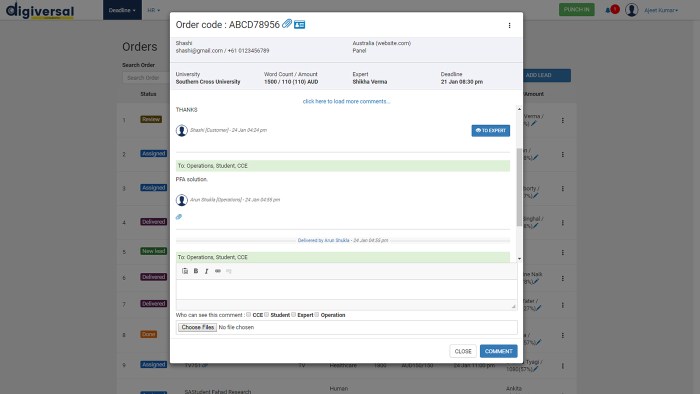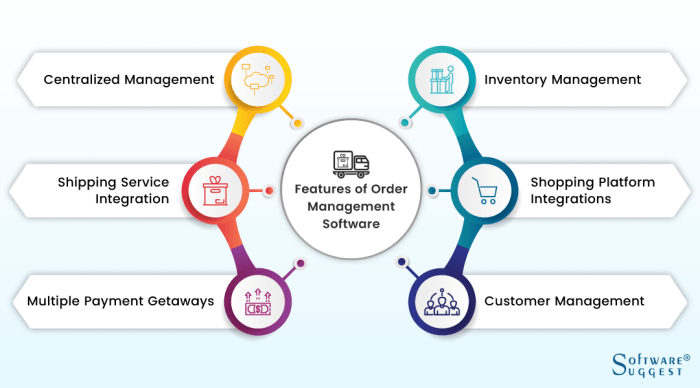Crm and order management software – In today’s dynamic business landscape, efficient management of customer relationships and orders is paramount to success. This necessitates the integration of robust Customer Relationship Management (CRM) and Order Management Software (OMS) systems. While often considered separately, these systems are increasingly intertwined, offering synergistic benefits when implemented together. This detailed guide explores the intricacies of both CRM and OMS, highlighting their individual functionalities, the advantages of their integration, and key considerations for selection and implementation.
Understanding Customer Relationship Management (CRM) Software
CRM software is a centralized system designed to manage and analyze customer interactions and data throughout the customer lifecycle. Its core function is to improve business relationships with current and prospective customers. This is achieved through various functionalities, including:
Key Features of CRM Software:
- Contact Management: Storing and organizing detailed customer information, including contact details, purchase history, and communication logs. This enables personalized interactions and targeted marketing campaigns.
- Sales Force Automation (SFA): Automating sales processes, such as lead management, opportunity tracking, and sales forecasting. This improves sales efficiency and predictability.
- Marketing Automation: Automating marketing tasks, such as email marketing, social media campaigns, and personalized messaging. This enhances customer engagement and brand loyalty.
- Customer Service Management: Managing customer inquiries and complaints through various channels (e.g., email, phone, chat). This improves customer satisfaction and reduces resolution times.
- Reporting and Analytics: Providing insightful data on customer behavior, sales performance, and marketing effectiveness. This enables data-driven decision-making and continuous improvement.
- Integration Capabilities: Connecting with other business systems, such as accounting software and e-commerce platforms. This ensures data consistency and streamlined workflows.
Types of CRM Software:
- Operational CRM: Focuses on automating and improving business processes related to sales, marketing, and customer service.
- Analytical CRM: Focuses on analyzing customer data to gain insights and improve decision-making.
- Collaborative CRM: Focuses on improving communication and collaboration between different departments and teams.
Examples of popular CRM software include Salesforce, HubSpot, Zoho CRM, and Microsoft Dynamics 365.
Understanding Order Management Software (OMS)
Order Management Software (OMS) is a system designed to streamline and optimize the entire order fulfillment process, from order placement to delivery. It centralizes order information, automates tasks, and provides real-time visibility into order status. Key functionalities include:
Key Features of OMS Software:, Crm and order management software
- Order Capture and Processing: Automating order entry from various channels (e.g., e-commerce website, phone, retail store).
- Inventory Management: Tracking inventory levels in real-time, managing stock replenishment, and preventing stockouts.
- Warehouse Management: Optimizing warehouse operations, including picking, packing, and shipping.
- Shipping and Delivery Management: Integrating with shipping carriers to generate shipping labels, track shipments, and manage delivery schedules.
- Returns Management: Managing the entire returns process, from initiating a return to processing a refund.
- Reporting and Analytics: Providing insights into order fulfillment performance, inventory levels, and shipping costs.
- Integration with other systems: Seamless integration with e-commerce platforms, CRM systems, and accounting software.
Benefits of using OMS:
- Improved Order Accuracy: Reduces errors in order processing and fulfillment.
- Faster Order Fulfillment: Streamlines the order fulfillment process, leading to faster delivery times.
- Reduced Costs: Optimizes inventory management and shipping costs.
- Enhanced Customer Satisfaction: Provides customers with real-time order tracking and proactive communication.
- Increased Efficiency: Automates manual tasks, freeing up employees to focus on other tasks.
Examples of popular OMS software include NetSuite, Shopify, Oracle Commerce Cloud, and Salesforce Order Management.
The Synergy of CRM and OMS Integration
Integrating CRM and OMS creates a powerful synergy, providing a holistic view of the customer journey and enabling businesses to deliver exceptional customer experiences. This integration allows for:

Source: orderms.com
- 360-degree Customer View: Provides a complete picture of each customer, including their purchase history, communication history, and order status.
- Personalized Customer Experiences: Enables businesses to personalize interactions and offers based on customer preferences and past behavior.
- Improved Customer Service: Allows customer service representatives to access complete customer information and order history, enabling faster and more effective resolution of issues.
- Proactive Customer Communication: Enables businesses to proactively communicate with customers about order status, shipping updates, and other relevant information.
- Data-Driven Decision Making: Provides access to comprehensive data on customer behavior, order fulfillment performance, and other key metrics, enabling data-driven decision-making.
- Streamlined Operations: Automates tasks and reduces manual data entry, improving efficiency and reducing errors.
Choosing the Right CRM and OMS Software
Selecting the right CRM and OMS software requires careful consideration of various factors, including:
- Business Size and Needs: Consider the size of your business and your specific needs. Smaller businesses may require simpler, more affordable solutions, while larger businesses may require more sophisticated, scalable systems.
- Integration Capabilities: Ensure that the chosen software integrates seamlessly with your existing systems, such as e-commerce platforms, accounting software, and other business applications.
- Scalability: Choose software that can scale with your business as it grows. This ensures that your system can handle increasing volumes of data and transactions.
- User-Friendliness: Select software that is easy to use and understand, minimizing the learning curve for your employees.
- Cost: Consider the total cost of ownership, including licensing fees, implementation costs, and ongoing maintenance.
- Vendor Support: Ensure that the vendor provides reliable and responsive customer support.
Frequently Asked Questions (FAQ): Crm And Order Management Software
- Q: What is the difference between CRM and OMS? A: CRM focuses on managing customer relationships, while OMS focuses on managing the order fulfillment process. While distinct, they are highly complementary.
- Q: Do I need both CRM and OMS software? A: While not strictly required, integrating both systems significantly enhances efficiency and customer experience, especially for businesses with substantial order volumes and a focus on customer retention.
- Q: How much does CRM and OMS software cost? A: Costs vary widely depending on the vendor, features, and scalability. Expect a range from affordable cloud-based options to enterprise-level solutions with substantial upfront and recurring costs.
- Q: How long does it take to implement CRM and OMS software? A: Implementation time depends on the complexity of the software and the size of your business. Expect a range from a few weeks to several months.
- Q: What are the key benefits of integrating CRM and OMS? A: Key benefits include a 360-degree customer view, personalized experiences, improved customer service, streamlined operations, and data-driven decision-making.
References
Call to Action
Ready to optimize your customer relationships and order fulfillment processes? Contact us today to learn how we can help you select and implement the right CRM and OMS solutions for your business needs. Let’s work together to elevate your business to new heights!
Helpful Answers
What are the key benefits of using integrated CRM and order management software?
Key benefits include improved customer satisfaction, increased efficiency, reduced errors, better inventory management, enhanced reporting and analytics, and ultimately, increased profitability.
How much does CRM and order management software typically cost?

Source: behance.net
Pricing varies greatly depending on the features, scalability, and vendor. Expect a range from affordable cloud-based solutions to enterprise-level systems with significant upfront investment.
What are some common integration challenges?
Common challenges include data migration, system compatibility issues, and the need for robust training for staff. Careful planning and selection of a reputable vendor can mitigate these challenges.

Source: amazonaws.com
How can I choose the right CRM and order management software for my business?
Consider your business size, specific needs, budget, and existing IT infrastructure. Research different vendors, compare features, and request demos before making a decision.
